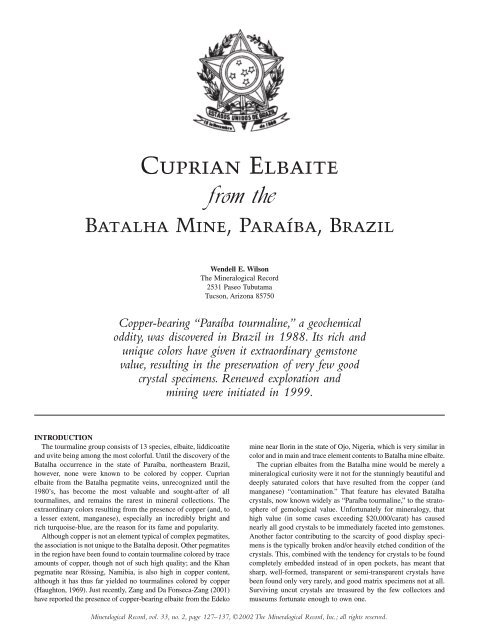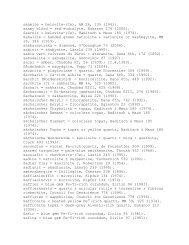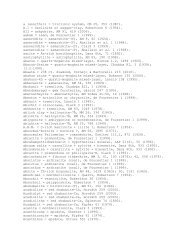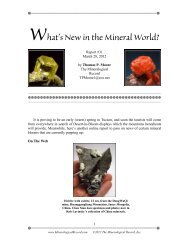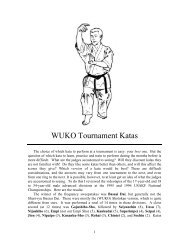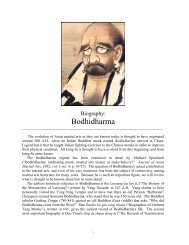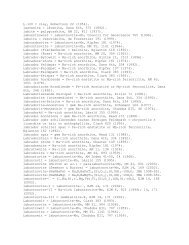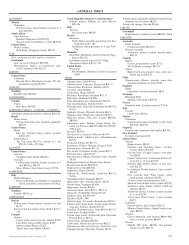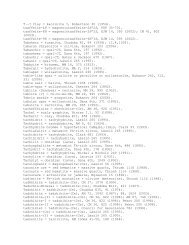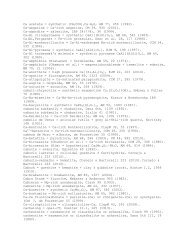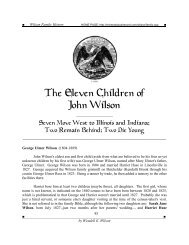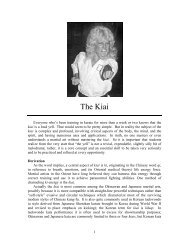Cuprian Elbaite - The Mineralogical Record
Cuprian Elbaite - The Mineralogical Record
Cuprian Elbaite - The Mineralogical Record
Create successful ePaper yourself
Turn your PDF publications into a flip-book with our unique Google optimized e-Paper software.
<strong>Cuprian</strong> <strong>Elbaite</strong><br />
from the<br />
Batalha Mine, Paraíba, Brazil<br />
<strong>The</strong> <strong>Mineralogical</strong> <strong>Record</strong>, volume 33, March–April, 2002<br />
Wendell E. Wilson<br />
<strong>The</strong> <strong>Mineralogical</strong> <strong>Record</strong><br />
2531 Paseo Tubutama<br />
Tucson, Arizona 85750<br />
Copper-bearing “Paraíba tourmaline,” a geochemical<br />
oddity, was discovered in Brazil in 1988. Its rich and<br />
unique colors have given it extraordinary gemstone<br />
value, resulting in the preservation of very few good<br />
crystal specimens. Renewed exploration and<br />
mining were initiated in 1999.<br />
INTRODUCTION<br />
<strong>The</strong> tourmaline group consists of 13 species, elbaite, liddicoatite<br />
and uvite being among the most colorful. Until the discovery of the<br />
Batalha occurrence in the state of Paraíba, northeastern Brazil,<br />
however, none were known to be colored by copper. <strong>Cuprian</strong><br />
elbaite from the Batalha pegmatite veins, unrecognized until the<br />
1980’s, has become the most valuable and sought-after of all<br />
tourmalines, and remains the rarest in mineral collections. <strong>The</strong><br />
extraordinary colors resulting from the presence of copper (and, to<br />
a lesser extent, manganese), especially an incredibly bright and<br />
rich turquoise-blue, are the reason for its fame and popularity.<br />
Although copper is not an element typical of complex pegmatites,<br />
the association is not unique to the Batalha deposit. Other pegmatites<br />
in the region have been found to contain tourmaline colored by trace<br />
amounts of copper, though not of such high quality; and the Khan<br />
pegmatite near Rössing, Namibia, is also high in copper content,<br />
although it has thus far yielded no tourmalines colored by copper<br />
(Haughton, 1969). Just recently, Zang and Da Fonseca-Zang (2001)<br />
have reported the presence of copper-bearing elbaite from the Edeko<br />
mine near Ilorin in the state of Ojo, Nigeria, which is very similar in<br />
color and in main and trace element contents to Batalha mine elbaite.<br />
<strong>The</strong> cuprian elbaites from the Batalha mine would be merely a<br />
mineralogical curiosity were it not for the stunningly beautiful and<br />
deeply saturated colors that have resulted from the copper (and<br />
manganese) “contamination.” That feature has elevated Batalha<br />
crystals, now known widely as “Paraíba tourmaline,” to the stratosphere<br />
of gemological value. Unfortunately for mineralogy, that<br />
high value (in some cases exceeding $20,000/carat) has caused<br />
nearly all good crystals to be immediately faceted into gemstones.<br />
Another factor contributing to the scarcity of good display specimens<br />
is the typically broken and/or heavily etched condition of the<br />
crystals. This, combined with the tendency for crystals to be found<br />
completely embedded instead of in open pockets, has meant that<br />
sharp, well-formed, transparent or semi-transparent crystals have<br />
been found only very rarely, and good matrix specimens not at all.<br />
Surviving uncut crystals are treasured by the few collectors and<br />
museums fortunate enough to own one.<br />
<strong>Mineralogical</strong> <strong>Record</strong>, vol. 33, no. 2, page 127–137, ©2002 <strong>The</strong> <strong>Mineralogical</strong> <strong>Record</strong>, Inc.; all rights reserved.<br />
127
Figure 2. Location of<br />
the Batalha mine and<br />
two other mines known<br />
for cuuprian elbaite, in<br />
the Seridó Fold Belt<br />
(SFB) (after Rodrigues<br />
Soares et al., 2000).<br />
128<br />
Figure 1. Location map<br />
showing the Batalha<br />
mine at the southern<br />
end of the Seridó<br />
pegmatitic province<br />
(adapted from<br />
Sinkankas, 1981).<br />
<strong>The</strong> <strong>Mineralogical</strong> <strong>Record</strong>, volume 33, March–April, 2002
Because these rare crystals have such significance as specimens<br />
for the mineralogist and collector, and because virtually all that has<br />
been written about them has appeared only in the gemological<br />
literature, the following summary is provided for <strong>Mineralogical</strong><br />
<strong>Record</strong> readers. Except as noted, all of the information presented<br />
here has been taken from Fritsch et al. (1990) and from Karfunkel<br />
and Wegner (1996).<br />
LOCATION<br />
<strong>The</strong> Batalha mine (“Mina da Batalha,” pronounced “Bat-tal-ya”)<br />
is situated in the Serra das Queimadas mountain range, on the side<br />
of Frade Hill (“Serra da Frade”), very near the village of São José<br />
da Batalha, and about 4.5 km northeast of the town of Salgadinho<br />
in the state of Paraíba, Brazil. <strong>The</strong> full name of the mine is “Mina<br />
da Batalha a Nova Era” (“Mine of the Battle of the New Era”) but<br />
“Mina da Batalha” is in general use, and some cite the name of the<br />
village (São José da Batalha) as also being the mine name. <strong>The</strong><br />
harsh and dry scrubland of the area supports little agriculture, but<br />
for decades a small local mining industry has focused on industrial<br />
pegmatite minerals, especially tantalite. Access is via a good<br />
highway west from the town of Campina Grande through Soledad<br />
and Juazeirinho, and from there about 42 km more due west to<br />
Salgadinho.<br />
HISTORY<br />
Attractive elbaite was first noticed in the area by Marcus<br />
Amaral, a geologist with the Mining and Geology Department of<br />
the Federal University of Paraíba in the late 1970’s, but the<br />
potential of the deposits was not immediately recognized. In 1982,<br />
Jose Pereira of Patos, a local Paraíba garimpeiro and dealer in<br />
“black minerals” (columbite-tantalite), found a tantalite specimen<br />
containing tiny grains resembling colored sugar. Eventually he<br />
offered the specimen to another miner, Heitor Dimas Barbosa, who<br />
suspected that the colorful grains (later shown to be cuprian<br />
elbaite) might indicate the presence of gem minerals. With Pereira<br />
<strong>The</strong> <strong>Mineralogical</strong> <strong>Record</strong>, volume 33, March–April, 2002<br />
Figure 3. <strong>The</strong> village of São José da Batalha;<br />
the Batalha mine is visible in the distance.<br />
Brendan Laurs photo.<br />
as his guide, Barbosa began exploring the mine dumps and tailings<br />
of the area’s industrial pegmatites (normally exploited for tantalum,<br />
industrial beryl, kaolinite, quartz and mica). In 1983 they<br />
finally relocated the source of the specimens, a small, abandoned<br />
manganotantalite prospect (Koivula and Kammerling, 1990).<br />
Over the next few years a team of 10 to 16 garimpeiros headed<br />
by Barbosa excavated shafts and galleries in the decomposed<br />
pegmatite, finding primarily tourmaline of various common shades<br />
of green. In August of 1988, however, they encountered strikingly<br />
colored “electric” blue and sapphire-blue tourmaline: these were<br />
the first of what came to be known as “copper tourmaline,” or<br />
“Paraíba tourmaline.”<br />
Barbosa and his associates filed a claim on the deposit in 1988,<br />
and formed a mining cooperative (COGASBRA) which they<br />
registered with the DNPM (Brazilian National Department of<br />
Minerals). Nevertheless, the mining rights were disputed and<br />
lengthy litigation ensued, during which time little productive<br />
mining activity took place. <strong>The</strong> controversy was finally resolved in<br />
1998, a consequence of the settlement being that the deposit was<br />
broken into three more or less equal pieces, of which Barbosa got<br />
one. Heitor and Sergio Barbosa then reactivated their portion of the<br />
property (Austin, 2001). Land adjacent to the mine was also<br />
opened up for exploration and mining (Cook and Barbosa, 1999).<br />
When Laurs and Shigley (2000) visited the mine in August of<br />
2000, mining was proceeding carefully under the guidance of<br />
Heitor Barbosa; two teams of miners had begun working new areas<br />
of the pegmatite, and underground fluorescent lighting had just<br />
been installed. Barbosa was also constructing facilities to process<br />
the old mine tailings, and another group, T.O.E. Mineração Ltda. (a<br />
subsidiary of Treasures of the Earth, a Nevada corporation), had<br />
recovered considerable quantities of gem rough by processing<br />
alluvial sediments down-slope from the mine. In February of 1999<br />
the T.O.E. group signed a 7.5-year agreement to mine the de Souza<br />
property, which includes part of Serra da Frade itself and some of<br />
the flat land surrounding the hill where alluvial deposits have<br />
129
130<br />
Figure 4. <strong>The</strong> Batalha mine workings on Frade<br />
Hill. Brendan Laurs photo.<br />
developed; the operation has been very successful. Removal and<br />
processing of alluvial/eluvial material has also uncovered additional<br />
tourmaline-bearing pegmatite veins (Austin, 2001). <strong>The</strong><br />
Batalha mine is a labyrinth consisting of shafts 50 to 60 meters in<br />
depth connected by several kilometers of hand-dug drifts and adits<br />
exploiting the complex system of pegmatite dikes. <strong>The</strong> narrow<br />
tunnels (originally only about 60 x 180 cm, though some have now<br />
been significantly enlarged to around 2 meters high and 1.5 meters<br />
across) were all worked solely by candlelight, under conditions of<br />
poor ventilation, during the 1980’s and early 1990’s, but have been<br />
modernized somewhat in recent years.<br />
It was estimated in 1990 that approximately 10,000 carats (2 kg)<br />
of rough crystals and cut stones had been produced from the mine<br />
before legal difficulties restricted mining activity. Additional pockets<br />
were discovered underground in 1993 and 1998, but since then<br />
the bulk of production of gem rough has come from the processing<br />
of alluvial material (Austin, 2001).<br />
GEOLOGY<br />
<strong>The</strong> Batalha occurrence is situated within a large, well-known<br />
pegmatite province containing hundreds of pegmatite bodies that<br />
have produced feldspar, quartz, mica and columbite-tantalite. At<br />
Batalha the geology consists of a parallel to sub-parallel system of<br />
steeply dipping, thoroughly decomposed granitic pegmatite dikes<br />
cutting across a hard muscovite-quartzite country rock. This rock<br />
unit, known as the Ecuador Formation of the Mid-Proterozoic<br />
Serido Group, is part of the Borborema geologic province (Almeida<br />
et al., 1981). <strong>The</strong> dikes are thought to have formed during the<br />
Upper Proterozoic (650–600 ma) Braziliano thermotectonic cycle.<br />
Feldspars in the pegmatites have all been completely altered to<br />
white, chalky kaolinite. Gem-quality tourmaline crystals are found<br />
embedded in this clay, and within small clay-filled pockets in the<br />
core zones of the pegmatites. Most tourmaline crystals have been<br />
broken by natural tectonic forces, and show moderate to severe<br />
etching. Some crystals have also been partially or completely<br />
altered to lepidolite. Associated minerals include quartz, lepidolite,<br />
schorl, dark green non-cuprian elbaite and Nb-Ta oxides.<br />
Figure 5. Old workings at the Batalha mine<br />
from which much cuprian elbaite was taken.<br />
Brendan Laurs photo.<br />
<strong>The</strong> <strong>Mineralogical</strong> <strong>Record</strong>, volume 33, March–April, 2002
Figure 6. Active workings in<br />
the Batalha mine, at about<br />
the 50-meter level, in August<br />
of 2000. Pneumatic drills are<br />
used to work the pegmatite<br />
(here dipping at about 65º).<br />
Brendan Laurs photo.<br />
<strong>The</strong> vein-like pegmatite bodies measure 20 to 140 cm in<br />
thickness. One area that has been particularly productive of gem<br />
cuprian elbaite is known as the “Heitorita trend,” especially at a<br />
depth of about 35 meters (Barbosa and Cook, 1991). <strong>The</strong> main<br />
dikes in the trend are generally referred to by number, one through<br />
five.<br />
Other pegmatites in the general area which have been found to<br />
contain cuprian elbaite (always of lower quality) plot within a<br />
narrow north-northeast-trending band extending for some 90 km.<br />
<strong>The</strong>y include the Capoeira pegmatite (where the cuprian elbaite is<br />
typically strongly color-zoned pink, blue, purple, green and gray),<br />
also known as the Boqueirãozinho pegmatite and the CDM or<br />
Mulungu mine. However, erroneous localities for cuprian elbaite<br />
have also been circulated, apparently to deter and confuse compet-<br />
<strong>The</strong> <strong>Mineralogical</strong> <strong>Record</strong>, volume 33, March–April, 2002<br />
ing interests; these include names such as Salgadinho, the Pedra<br />
Bonita spessartine occurrence near Carnaúba dos Dantas, Cajazeiros,<br />
Riach do Pinga, Junco do Seridó, Pedra Lavrada, and Serra dos<br />
Quintos, none of which have actually produced any cuprian elbaite.<br />
Serra dos Quintos, however, should not be confused with the<br />
productive Quintos pegmatite, also known as the Wild mine (Laurs<br />
and Shigley, 2000). Traces of copper have also been found in<br />
tourmaline from the Gregório pegmatite near Parelhas (Soares<br />
et al., 2000; Adusumilli et al., 1994).<br />
<strong>The</strong> high copper content of the pegmatites was apparently<br />
derived from underlying Cu-bearing sediments during chemical<br />
mobilization associated with the Brasiliano thermotectonic cycle.<br />
Veins containing copper sulfides have been found nearby at Serra<br />
Negra, at a site between Parelhas and Pedra Lavrada, at an<br />
131
132<br />
Figure 7. Across-section of one of the pegmatite<br />
veins visible in the roof of a tunnel at the<br />
Batalha mine. Brendan Laurs photo.<br />
Figure 8. <strong>Cuprian</strong> elbaite, 3.3 cm, from the<br />
Batalha mine (ca. 1989). Brian Cook specimen;<br />
Wendell Wilson photo.<br />
occurrence near Nova Palmeira, in the scheelite skarns of Currais<br />
Novos, and very near the Capoeira/Boqueirãozinho pegmatite (see<br />
Falster et al., 2000, and the article on the latter occurrence by<br />
Robinson and Wegner, 1998). Other metallic elements which have<br />
also been found locally in pegmatites (U, W, Ta, Sn, Nb, Mn) have<br />
been perceived by some authors to be arrayed in broad concentric<br />
zones radiating outward from the center of the pegmatite field, the<br />
copper-containing tourmaline band being parallel to these zones<br />
and therefore presumably genetically related to the core pluton<br />
(Cook and Barbosa, 1999); this theory still requires confirmation.<br />
MINERALOGY<br />
Batalha-mine cuprian elbaite occurs in a range of rich colors,<br />
from yellow-green to emerald-green, blue-green, turquoise-blue,<br />
tanzanite-blue, sapphire-blue, “electric” blue, bluish purple, purple,<br />
purplish pink, pink and gray—each color valued differently by the<br />
gem market. Many individual crystals are concentrically zoned in<br />
several colors. High concentrations of copper (1.5 to 2.3 weight %<br />
CuO) plus some manganese are responsible for the turquoise-blue<br />
color, whereas lower copper (< 0.6 wt.%) in the presence of<br />
manganese results in the purple color. Low manganese (< 0.1 wt.%)<br />
and high copper produce a green color. Pleochroism is usually<br />
distinct, from medium blue to pale greenish blue. <strong>The</strong> highest<br />
concentration of manganese (2.99 wt.% MnO) was found in a<br />
greenish gray crystal. Some colors are produced or enhanced by<br />
heat treatment, such treatment not always being determinable after<br />
the fact.<br />
Indices of refraction are typical of elbaite (1.618–1.612 and<br />
1.638–1.646); specific gravity (3.03–3.12) is slightly higher than<br />
usual. <strong>The</strong> crystals are unresponsive to longwave and shortwave<br />
ultraviolet light. <strong>The</strong> X-ray diffraction pattern is closely similar to<br />
that of standard elbaite, yielding a unit cell of a = 15.883 and c =<br />
7.111 Å.<br />
Numerous yellowish specks have been found included in some<br />
crystals; X-ray fluorescence analysis indicated the presence of Mn,<br />
Fe, Cu, Zn, Bi and S, suggesting a complex sulfide. However,<br />
Brandstätter and Niedermayr (1993, 1994) investigated the metallic<br />
<strong>The</strong> <strong>Mineralogical</strong> <strong>Record</strong>, volume 33, March–April, 2002
Figure 9. <strong>Cuprian</strong> elbaite<br />
crystal from the Batalha mine<br />
showing blue and turquoiseblue<br />
zones, 3 cm, with 2-carat<br />
(9-mm) cut stone. Michael Scott<br />
collection; Van Pelt photo<br />
courtesy of Michael Scott.<br />
Figure 10. <strong>Cuprian</strong> elbaite,<br />
2.2 cm, from the Batalha mine<br />
(ca. 1989). Brian Cook specimen;<br />
Wendell Wilson photo.<br />
inclusions noted earlier by others and found them to be native<br />
copper; inclusions of black tenorite were also found in elbaite. <strong>The</strong><br />
copper appears to have formed by epigenetic exsolution from elbaite.<br />
Chemically the Batalha cuprian elbaites are typical of other<br />
elbaites in their low Ti (< 0.11 wt.% TiO 2) and Fe (< 0.34 wt.%<br />
Fe 2O 3) contents and the virtual absence of V and Cr. <strong>The</strong> high<br />
concentration of Cu is, of course, quite unusual.<br />
Small amounts of Bi, Pb, Zn and Au were also detected in many<br />
specimens: these trace elements apparently have no influence on<br />
color. Site-occupancy and charge-balance considerations indicate<br />
that the copper and manganese are present in the Y crystallographic<br />
site, substituting for aluminum. <strong>The</strong>refore the formula can be<br />
written as: Na(Li,Al) 3(Al,Cu,Mn) 6(BO 3)Si 6) 18(OH) 4. Heat treatment<br />
of the crystals is said to be commonly practiced; the affect is<br />
<strong>The</strong> <strong>Mineralogical</strong> <strong>Record</strong>, volume 33, March–April, 2002<br />
the reduction of Mn 3+ to Mn 2+ , removing the pink and purplish<br />
colors to leave a pure turquoise-blue. Heat treatment has no effect<br />
on the absorption attributable to copper, although blue and green<br />
colors can be influenced by heat treatment because of the presence<br />
of trace amounts of Mn.<br />
Morphologically the Batalha mine elbaites are roughly trigonal<br />
in cross-section but are somewhat irregular in outline. Zoning in<br />
some crystals shows that etching has not significantly affected their<br />
overall shape, whereas other crystals appear more heavily etched.<br />
Terminations, where present, are usually trigonal rhombohedrons<br />
or a flat pedion. Terminated crystals, however, are much rarer than<br />
broken fragments. One heavily fractured crystal would have measured<br />
about 30 cm, had it been recovered intact (Wilson, 1991).<br />
Surviving crystals are usually in the 1 to 3-cm size range. Koivula<br />
133
and Kammerling (1989) reported a “specimen quality” crystal<br />
(presumably meaning that it had no gem value) weighing 100<br />
grams (about a quarter of a pound). Koivula et al. (1993) reported<br />
seeing an exceptional 4.8-gram bicolored crystal (violet-blue to<br />
blue-green) with no eye-visible inclusions and with well-formed,<br />
striated prism faces. <strong>The</strong>y also reported seeing dark yellowish<br />
green crystals with metallic inclusions which were said to have<br />
been found below the level where the brightest blue crystals occur;<br />
further down only black schorl is said to be found.<br />
<strong>The</strong> Natural History Museum of Los Angeles County has an<br />
interesting specimen consisting of fractured and mostly unterminated<br />
non-gem-grade crystals of good color embedded in white quartz<br />
matrix and showing partial alteration to lepidolite. According to<br />
curator Anthony Kampf, several hundred such specimens, purport-<br />
134<br />
Figure 11. <strong>Cuprian</strong><br />
elbaite from the Batalha<br />
mine, 5-cm crystal with<br />
1.3-cm (4-carat) cut<br />
stone. Michael Scott<br />
collection; Van Pelt<br />
photo courtesy of<br />
Michael Scott.<br />
edly from the Batalha mine, were available in Brazil from Emilio<br />
Frois (New Gems Ltda. and Color Gemas company) at his warehouse<br />
in Governador Valadares in 2000 and 2001, and some of<br />
these later appeared among the stock of other dealers at the 2001<br />
Denver Gem and Mineral Show. <strong>The</strong>se specimens provide systematic<br />
collectors and museum curators with an opportunity to acquire<br />
study-grade examples of cuprian elbaite at a price well below that<br />
of gem-grade crystals. However, it is not at all certain that this<br />
material is from the Batalha mine; similar cuprian elbaite specimens<br />
sold in Tucson a few years ago came from the Wild mine (the<br />
Alto dos Quintos, or just Quintos, pegmatite), owned by Paul Wild<br />
of Idar-Oberstein, located about 60 km northeast of Batalha in Rio<br />
Grande do Norte state (Brendan Laurs, personal communication,<br />
2001).<br />
<strong>The</strong> <strong>Mineralogical</strong> <strong>Record</strong>, volume 33, March–April, 2002
Figure 12. <strong>Cuprian</strong> elbaite, 2.3 cm, from the<br />
Batalha mine (ca. 1989). Brian Cook specimen;<br />
Wendell Wilson photo.<br />
Figure 14. <strong>Cuprian</strong> elbaite crystal section, 3 cm,<br />
turquoise-blue with purple core, from the Batalha<br />
mine (ca. 1989). Brian Cook specimen;<br />
Wendell Wilson photo.<br />
<strong>The</strong> <strong>Mineralogical</strong> <strong>Record</strong>, volume 33, March–April, 2002<br />
Figure 13. <strong>Cuprian</strong> elbaite, 1.7 cm, from the<br />
Batalha mine (ca. 1989). Wendell Wilson collection<br />
and photo.<br />
135
136<br />
Figure 15. <strong>Cuprian</strong> elbaite scepter crystal, 2 cm,<br />
from the Batalha mine. Michael Scott collection;<br />
Van Pelt photo courtesy of Michael Scott.<br />
Finally, it should be noted as a warning that some marketers<br />
have been offering blue-to-green copper-free tourmaline as Paraíba<br />
tourmaline in order to obtain a much higher price<br />
CONCLUSIONS<br />
Although the area in northeastern Brazil where occurrences of<br />
cuprian elbaite have been found is fairly large, none of the<br />
localities has produced crystals equal to those found at the Batalha<br />
mine. Furthermore, almost all good crystals of any size tend to be<br />
shattered, and the remainder are generally embedded, non-gemmy<br />
and not of good collector quality. As long as mining continues in<br />
the area, the possibility of more good crystals being found exists,<br />
but their extremely high gem value probably means that most will<br />
continue to be cut as gemstones rather than saved as crystal<br />
Figure 17 . <strong>Cuprian</strong> elbaite crystal section,<br />
1.5 cm, turquoise-blue with purple core, from<br />
the Batalha mine (ca. 1989). Brian Cook specimen;<br />
Wendell Wilson photo.<br />
Figure 16. Faceted cuprian elbaites showing a<br />
range of color. Michael Scott collection; Van<br />
Pelt photo courtesy of Michael Scott.<br />
specimens. Consequently, even very small crystals of good color,<br />
form and transparency will probably remain very rare in collections<br />
and on the market.<br />
ACKNOWLEDGMENTS<br />
I am grateful to Brendan Laurs and James Shigley (Gemological<br />
Institute of America) and Anthony Kampf (Natural History Museum<br />
of Los Angeles County) for reviewing the manuscript, and<br />
for graciously providing information and photos. Brian Cook<br />
(Nature’s Geometry) also provided information and loaned specimens<br />
for photography.<br />
BIBLIOGRAPHY<br />
ADUSUMILLI, M. S., CASTRO, C., and BHASKARA RAO, A.<br />
(1994) Blue and green gem tourmaline from Gregório pegmatite,<br />
Rio Grande do Norte State. In: 16th General Meeting of the<br />
International <strong>Mineralogical</strong> Association, Pisa, Italy, 1–13.<br />
ALMEIDA, F. F. M., HASUI, Y., BRITO NEVES, B. B., AND<br />
FUCK, R. A. (1981) Brazilian structural provinces: an introduction.<br />
Earth Science Review, 17, 1–29.<br />
AUSTIN, G. T. (2001) Reviving a legend. Colored Stone, 14 (1),<br />
510–511.<br />
BANK, H., and HENN, U. (1990) Paraíba tourmaline: beauty and<br />
rarity. Jewellery News Asia, no. 70, 62, 64.<br />
BANK, H., HENN, U., BANK, F. H., von PLATEN, H., and<br />
HOFMEISTER, W. (1990) Leuchtendblaue Cu-führende Turmaline<br />
aus Paraíba, Brasilien. Zeitschrift der Deutschen Gemmologischen<br />
Gesellschaft, 39 (1), 3–11.<br />
BARBOSA, H., and COOK, B. C. (1991) Copper tourmaline from<br />
Paraíba, Brazil. Privately printed circular, 1 p.<br />
BRANDSTÄTTER, F., and NIEDERMAYR, G. (1993) Einschlüsse<br />
von gediegen Kupfer in Cu-elbaite von São José da Batalha,<br />
Paraíba, Brazilien. Zeitschrift der Deutschen Gemmologischen<br />
Gesellschaft, 42 (1), 37–41.<br />
BRANDSTÄTTER, F., and NIEDERMAYR, G. (1994) Copper<br />
<strong>The</strong> <strong>Mineralogical</strong> <strong>Record</strong>, volume 33, March–April, 2002
and tenorite inclusions in cuprian-elbaite tourmaline from Paraíba,<br />
Brazil. Gems & Gemology, 30 (3), 178–183.<br />
COOK, B. C., and BARBOSA, H. D. (1999) Copper tourmaline of<br />
Paraíba, Brazil; reopening of the mine; regional exploration.<br />
[Abstract] in Proceedings of the third International Gemological<br />
Symposium. Gems & Gemology, 35 (3), 138.<br />
FALSTER, A. U., SIMMONS, W. B., NIZAMOFF, J. W., and<br />
WEBBER, K. L. (2000) <strong>Cuprian</strong> elbaite from the Bocheirão<br />
Zinho pegmatite, Paraíba, Brazil (Abstract). <strong>Mineralogical</strong><br />
<strong>Record</strong>, 31, 181–182.<br />
FEDERMAN, D. (1990) Gem profile. Paraíba tourmaline: toast of<br />
the trade. Modern Jeweler, 89 (1), 48.<br />
FRITSCH, E., SHIGLEY, J. E., ROSSMAN, G. R., MERCER,<br />
M. E., MUHLMEISTER, S. M., and MOON, M. (1990) Gemquality<br />
cuprian-elbaite tourmalines from São José da Batalha,<br />
Paraíba, Brazil. Gems & Gemology, 26 (3), 189–205.<br />
HAUGHTON, S. H. (1969) Geological History of Southern Africa.<br />
Geological Society of South Africa, Cape Town, 535 p.<br />
HENN, U., and BANK, H. (1990) On the colour and pleochroism<br />
of Cu-bearing green and blue tourmalines from Paraíba, Brazil.<br />
Neues Jahrbuch für Mineralogie, Monatshefte, no. 6, 280–288.<br />
HENN, U., BANK, H., BANK, F. H., PLATEN, H., and HOF-<br />
MEISTER, W. (1990) Transparent, bright blue Cu-bearing tourmalines<br />
from Paraíba, Brazil. <strong>Mineralogical</strong> Magazine, 54, 553–<br />
557.<br />
KANE, R. (1989) Gem trade lab notes: Blue tourmaline from<br />
Brazil. Gems & Gemology, 25 (4) 241–242.<br />
KARFUNKEL, J., and WAGNER, R. R. (1996) Paraíba tourmalines:<br />
distribution, mode of occurrence and geologic environment.<br />
Canadian Gemmologist, 17 (4), 99–106.<br />
KOIVULA, J. I., and KAMMERLING, R. C. (1989a) Gem news:<br />
Unusual tourmalines from Brazil. Gems and Gemology, 25 (3),<br />
181–182.<br />
KOIVULA, J. I., and KAMMERLING, R. C. (1989b) Gem news:<br />
Paraíba tourmaline update. Gems & Gemology, 25 (4), 248.<br />
KOIVULA, J. I., and KAMMERLING, R. C. (1990) Gem news:<br />
<strong>The</strong> discovery of the Paraíba tourmaline mine. Gems & Gemology,<br />
26 (2), 164–165).<br />
KOIVULA, J. I., and KAMMERLING, R. C. (1991a) Gem news:<br />
Paraíba tourmaline. Gems & Gemology, 27 (1), 51.<br />
<strong>The</strong> <strong>Mineralogical</strong> <strong>Record</strong>, volume 33, March–April, 2002<br />
KOIVULA, J. I., and KAMMERLING, R. C. (1991b) Gem news:<br />
Large Paraíba tourmalines. Gems & Gemology, 27 (3), 184.<br />
KOIVULA, J. I., KAMMERLING, R. C., and FRITSCH, E.<br />
(1992a) Gem news: Tourmaline from Paraíba, Brazil. Gems &<br />
Gemology, 28 (1), 62.<br />
KOIVULA, J. I., KAMMERLING, R. C., and FRITSCH, E.<br />
(1992b) Gem news: Tourmaline with distinctive inclusions.<br />
Gems & Gemology, 28 (3), 204.<br />
KOIVULA, J. I., KAMMERLING, R. C., and FRITSCH, E.<br />
(1993) Gem notes: Tourmaline from Paraíba, Brazil. Gems &<br />
Gemology, 29 (1), 62–63.<br />
KOIVULA, J. I., KAMMERLING, R. C., and FRITSCH, E.<br />
(1994) Gem news: Miscellaneous notes on tourmaline. Gems &<br />
Gemology, 30 (1), 55.<br />
LAURS, B. M., and SHIGLEY, J. E. (2000) Gem news: Paraíba<br />
tourmaline update. Gems & Gemology, 36 (3), 269–271.<br />
ROBINSON, G. W., and WEGNER, R. R. (1998) Mineralogy of<br />
the Boqueirãozinho pegmatite, Parelhas, Rio Grande do Norte,<br />
Brazil. <strong>Mineralogical</strong> <strong>Record</strong>, 29, 193–197.<br />
ROSSMAN, G. R., FRITSCH, E., and SHIGLEY, J. E. (1991)<br />
Origin of color in cuprian elbaite from São José da Batalha,<br />
Paraíba, Brazil. American Mineralogist, 76 (9/10), 1479–1484.<br />
ROY, L. R., DOTTON, O., and MADON, H. L. (1964) Estudos dos<br />
pegmatitos do Rio Grande do Norte e da Paraíba. Sudene, Dept.<br />
de Recursos Naturais Divisão Geologia, serie geologia economica<br />
No. 1.<br />
SHIGLEY, J. E., COOK, B. C., LAURS, B. M., and BERNARDES,<br />
M. O. (2001) An update on Paraíba tourmaline from Brazil. Gems<br />
& Gemology, 37 (4), 260–276.<br />
SOARES, D. R., FERREIRA, A. C. M., RODRIGUES DA<br />
SILVA, R., and FERREIRA, V. P. (2000) Alkali-deficient elbaite<br />
from pegmatites of the Seridó region, Borborema Province, NE<br />
Brazil. Revista Brasileira de Geociências, 30 (2), 293–296.<br />
WILSON, W. E. (1991) What’s new in minerals? Tucson Show<br />
1991. <strong>Mineralogical</strong> <strong>Record</strong>, 22, 217, 219.<br />
ZANG, J. W., and DA FONSECA-ZANG, W. A. (2001) Cu-haltige<br />
<strong>Elbaite</strong> aus Nigeria. Berichte der Deutschen Mineralogischen<br />
Desellschaft, Beihefte zum European Journal of Mineralogy, 13,<br />
202.<br />
137


